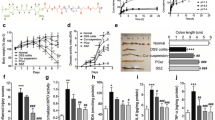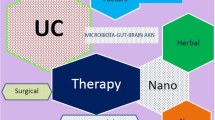Abstract
Inflammatory bowel diseases (IBD), which is classified into Crohn’s disease and ulcerative colitis, are among chronic gastrointestinal diseases with unknown pathogenesis. Diverse strategies have been applied for the treatment of this chronic disease. However, selective and site-specific routes of drug delivery to the inflamed location of the colon remain of high importance. Consequently, the application and effects of natural products in the form of nanoformulation and stimuli responsive nanoparticles as a novel strategy for the treatment of IBD are discussed in this review article. This approach may potentially overcome some complications that are associated with conventional means of colon drug delivery. Meanwhile, in vitro and in vivo studies pave the way for understanding of the mechanism that lies behind this chronic relapsing disease and potentially more effective treatment.

ᅟ



Similar content being viewed by others
Change history
26 November 2018
The corresponding author, Mohammad Hosein Farzaei, affiliation is Pharmaceutical Sciences Research Center, Kermanshah University of Medical Sciences, Kermanshah, Iran. The correct spelling of the 7th author surname is Iranpanah.
References
Beloqui A, Memvanga PB, Coco R, Reimondez-Troitiño S, Alhouayek M, Muccioli GG, et al. A comparative study of curcumin-loaded lipid-based nanocarriers in the treatment of inflammatory bowel disease. Colloids Surf B: Biointerfaces. 2016;143:327–35.
Cazarin CB, da Silva JK, Colomeu TC, Batista ÂG, Vilella CA, Ferreira AL, et al. Passiflora edulis peel intake and ulcerative colitis: approaches for prevention and treatment. Exp Biol Med. 2014;239(5):542–51.
Zhang M, Wang X, Han MK, Collins JF, Merlin D. Oral administration of ginger-derived nanolipids loaded with siRNA as a novel approach for efficient siRNA drug delivery to treat ulcerative colitis. Nanomedicine. 2017;12(16):1927–43.
Bribi N, Algieri F, Rodriguez-Nogales A, Vezza T, Garrido-Mesa J, Utrilla MP, et al. Intestinal anti-inflammatory effects of total alkaloid extract from Fumaria capreolata in the DNBS model of mice colitis and intestinal epithelial CMT93 cells. Phytomedicine. 2016;23(9):901–13.
Castro J, Ocampo Y, Franco L. Cape gooseberry [Physalis peruviana L.] calyces ameliorate TNBS acid-induced colitis in rats. J Crohn's Colitis. 2015;9(11):1004–15.
Hur SJ, Kang SH, Jung HS, Kim SC, Jeon HS, Kim IH, et al. Review of natural products actions on cytokines in inflammatory bowel disease. Nutr Res. 2012;32(11):801–16.
Saeidnia S, Abdollahi M. Toxicological and pharmacological concerns on oxidative stress and related diseases. Toxicol Appl Pharmacol. 2013;273(3):442–55.
Zhang M, Viennois E, Prasad M, Zhang Y, Wang L, Zhang Z, et al. Edible ginger-derived nanoparticles: a novel therapeutic approach for the prevention and treatment of inflammatory bowel disease and colitis-associated cancer. Biomaterials. 2016;101:321–40.
Mozaffari S, Nikfar S, Abdolghaffari AH, Abdollahi M. New biologic therapeutics for ulcerative colitis and Crohn's disease. Expert Opin Biol Ther. 2014;14(5):583–600.
Davatgaran-Taghipour Y, Masoomzadeh S, Farzaei MH, Bahramsoltani R, Karimi-Soureh Z, Rahimi R, et al. Polyphenol nanoformulations for cancer therapy: experimental evidence and clinical perspective. Int J Nanomedicine. 2017;12:2689–702.
Das S, Deshmukh R, Jha A. Role of natural polymers in the development of multiparticulate systems for colon drug targeting. Systematic Reviews in pharmacy. 2010;1(1):79.
Laroui H, Dalmasso G, Nguyen HTT, Yan Y, Sitaraman SV, Merlin D. Drug-loaded nanoparticles targeted to the colon with polysaccharide hydrogel reduce colitis in a mouse model. Gastroenterology 2010;138(3):843–853. e2.
Grivennikov SI, Karin M. Inflammatory cytokines in cancer: tumour necrosis factor and interleukin 6 take the stage. Ann Rheum Dis. 2011;70(Suppl 1):i104–i8.
Chan AT, Giovannucci EL. Primary prevention of colorectal cancer. Gastroenterology 2010;138(6):2029–2043. e10.
Fukata M, Shang L, Santaolalla R, Sotolongo J, Pastorini C, España C, et al. Constitutive activation of epithelial TLR4 augments inflammatory responses to mucosal injury and drives colitis-associated tumorigenesis. Inflamm Bowel Dis. 2010;17(7):1464–73.
Karimi M, Zare H, Bakhshian Nik A, Yazdani N, Hamrang M, Mohamed E, et al. Nanotechnology in diagnosis and treatment of coronary artery disease. Nanomedicine. 2016;11(5):513–30.
Karimi M, Ghasemi A, Zangabad PS, Rahighi R, Basri SMM, Mirshekari H, et al. Smart micro/nanoparticles in stimulus-responsive drug/gene delivery systems. Chem Soc Rev. 2016;45(5):1457–501.
Zangabad PS, Mirkiani S, Shahsavari S, Masoudi B, Masroor M, Hamed H, et al. Stimulus-responsive liposomes as smart nanoplatforms for drug delivery applications. Nanotechnol Rev. 2017.
Mura C, Nácher A, Merino V, Merino-Sanjuan M, Manconi M, Loy G, et al. Design, characterization and in vitro evaluation of 5-aminosalicylic acid loaded N-succinyl-chitosan microparticles for colon specific delivery. Colloids Surf B: Biointerfaces. 2012;94:199–205.
Seremeta KP, Chiappetta DA, Sosnik A. Poly (ɛ-caprolactone), Eudragit® RS 100 and poly (ɛ-caprolactone)/Eudragit® RS 100 blend submicron particles for the sustained release of the antiretroviral efavirenz. Colloids Surf B: Biointerfaces. 2013;102:441–9.
Collnot E-M, Ali H, Lehr C-M. Nano-and microparticulate drug carriers for targeting of the inflamed intestinal mucosa. J Control Release. 2012;161(2):235–46.
Meissner HI, Breen N, Klabunde CN, Vernon SW. Patterns of colorectal cancer screening uptake among men and women in the United States. Cancer Epidemiol Biomark Prev. 2006;15(2):389–94.
Xiao B, Zhang M, Viennois E, Zhang Y, Wei N, Baker MT, et al. Inhibition of MDR1 gene expression and enhancing cellular uptake for effective colon cancer treatment using dual-surface-functionalized nanoparticles. Biomaterials. 2015;48:147–60.
Xiao B, Si X, Zhang M, Merlin D. Oral administration of pH-sensitive curcumin-loaded microparticles for ulcerative colitis therapy. Colloids Surf B: Biointerfaces. 2015;135:379–85.
Beloqui A, Coco R, Memvanga PB, Ucakar B, des Rieux A, Préat V. pH-sensitive nanoparticles for colonic delivery of curcumin in inflammatory bowel disease. Int J Pharm 2014;473(1–2):203–212.
Gugulothu D, Kulkarni A, Patravale V, Dandekar P. pH-sensitive nanoparticles of curcumin–celecoxib combination: evaluating drug synergy in ulcerative colitis model. J Pharm Sci. 2014;103(2):687–96.
Ali H, Weigmann B, Neurath M, Collnot E, Windbergs M, Lehr C-M. Budesonide loaded nanoparticles with pH-sensitive coating for improved mucosal targeting in mouse models of inflammatory bowel diseases. J Control Release. 2014;183:167–77.
Mura S, Nicolas J, Couvreur P. Stimuli-responsive nanocarriers for drug delivery. Nat Mater. 2013;12(11):991–1003.
Castangia I, Nácher A, Caddeo C, Merino V, Díez-Sales O, Catalán-Latorre A, et al. Therapeutic efficacy of quercetin enzyme-responsive nanovesicles for the treatment of experimental colitis in rats. Acta Biomater. 2015;13:216–27.
Sinha V, Kumria R. Microbially triggered drug delivery to the colon. Eur J Pharm Sci. 2003;18(1):3–18.
Saphier S, Haft A, Margel S. Bacterial reduction as means for colonic drug delivery: can other chemical groups provide an alternative to the azo bond? J Med Chem. 2012;55(23):10781–5.
Qiao H, Fang D, Chen J, Sun Y, Kang C, Di L, et al. Orally delivered polycurcumin responsive to bacterial reduction for targeted therapy of inflammatory bowel disease. Drug Deliv. 2017;24(1):233–42.
Sun Q, Luan L, Arif M, Li J, Dong Q-J, Gao Y, et al. Redox-sensitive nanoparticles based on 4-aminothiophenol-carboxymethyl inulin conjugate for budesonide delivery in inflammatory bowel diseases. Carbohydr Polym. 2017.
Zhuang X, Deng Z-B, Mu J, Zhang L, Yan J, Miller D, et al. Ginger-derived nanoparticles protect against alcohol-induced liver damage. J Extracell Vesicles. 2015;4(1):28713.
Panahi Y, Badeli R, Karami GR, Sahebkar A. Investigation of the efficacy of adjunctive therapy with bioavailability-boosted curcuminoids in major depressive disorder. Phytother Res. 2015;29(1):17–21.
Ohno M, Nishida A, Sugitani Y, Nishino K, Inatomi O, Sugimoto M, et al. Nanoparticle curcumin ameliorates experimental colitis via modulation of gut microbiota and induction of regulatory T cells. PLoS One. 2017;12(10):e0185999.
Gazak R, Walterova D, Kren V. Silybin and silymarin-new and emerging applications in medicine. Curr Med Chem. 2007;14(3):315–38.
Katiyar SK, Roy AM, Baliga MS. Silymarin induces apoptosis primarily through a p53-dependent pathway involving Bcl-2/Bax, cytochrome c release, and caspase activation. Mol Cancer Ther. 2005;4(2):207–16.
Zamamiri-Davis F, Lu Y, Thompson JT, Prabhu KS, Reddy PV, Sordillo LM, et al. Nuclear factor-κB mediates over-expression of cyclooxygenase-2 during activation of RAW 264.7 macrophages in selenium deficiency. Free Radic Biol Med. 2002;32(9):890–7.
Duntas L. Selenium and inflammation: underlying anti-inflammatory mechanisms. Horm Metab Res. 2009;41(06):443–7.
Miroliaee AE, Esmaily H, Vaziri-Bami A, Baeeri M, Shahverdi AR, Abdollahi M. Amelioration of experimental colitis by a novel nanoselenium–silymarin mixture. Toxicol Mech Methods. 2011;21(3):200–8.
Varshosaz J, Minaiyan M, Khaleghi N. Eudragit nanoparticles loaded with silybin: a detailed study of preparation, freeze-drying condition and in vitro/in vivo evaluation. J Microencapsul. 2015;32(3):211–23.
Brown AC, Shah C, Liu J, Pham JT, Zhang JG, Jadus MR. Ginger's (Zingiber officinale roscoe) inhibition of rat colonic adenocarcinoma cells proliferation and angiogenesis in vitro. Phytother Res. 2009;23(5):640–5.
Grzanna R, Lindmark L, Frondoza CG. Ginger—an herbal medicinal product with broad anti-inflammatory actions. J Med Food. 2005;8(2):125–32.
Chessa M, Caddeo C, Valenti D, Manconi M, Sinico C, Fadda AM. Effect of penetration enhancer containing vesicles on the percutaneous delivery of quercetin through new born pig skin. Pharmaceutics. 2011;3(3):497–509.
Guazelli CF, Fattori V, Colombo BB, Georgetti SR, Vicentini FT, Casagrande R, et al. Quercetin-loaded microcapsules ameliorate experimental colitis in mice by anti-inflammatory and antioxidant mechanisms. J Nat Prod. 2013;76(2):200–8.
Caddeo C, Nácher A, Díez-Sales O, Merino-Sanjuán M, Fadda AM, Manconi M. Chitosan–xanthan gum microparticle-based oral tablet for colon-targeted and sustained delivery of quercetin. J Microencapsul. 2014;31(7):694–9.
Ju S, Mu J, Dokland T, Zhuang X, Wang Q, Jiang H, et al. Grape exosome-like nanoparticles induce intestinal stem cells and protect mice from DSS-induced colitis. Mol Ther. 2013;21(7):1345–57.
Chitra M, Sukumar E, Suja V, Devi S. Antitumor, anti-inflammatory and analgesic property of embelin. A plant product Chemotherapy. 1994;40(2):109–13.
Kumar K, Dhamotharan R, Kulkarni NM, Honnegowda S, Murugesan S. Embelin ameliorates dextran sodium sulfate-induced colitis in mice. Int Immunopharmacol. 2011;11(6):724–31.
Thippeswamy BS, Mahendran S, Biradar MI, Raj P, Srivastava K, Badami S, et al. Protective effect of embelin against acetic acid induced ulcerative colitis in rats. Eur J Pharmacol. 2011;654(1):100–5.
Badamaranahalli SS, Kopparam M, Bhagawati ST, Durg S. Embelin lipid nanospheres for enhanced treatment of ulcerative colitis–preparation. Characterization and in vivo Evaluation. Eur J Pharm Sci. 2015;76:73–82.
Jain A, Gupta Y, Jain SK. Perspectives of biodegradable natural polysaccharides for site-specific drug delivery to the colon. J Pharm Pharm Sci. 2007;10(1):86–128.
Zhou S, Zhang B, Liu X, Teng Z, Huan M, Yang T, et al. A new natural Angelica polysaccharide based colon-specific drug delivery system. J Pharm Sci. 2009;98(12):4756–68.
Li Y, Fan L, Tang T, Tang Y, Xie M, Zeng X, et al. Modified apple polysaccharide prevents colitis through modulating IL-22 and IL-22BP expression. Int J Biol Macromol. 2017;103:1217–23.
Laroui H, Wilson DS, Dalmasso G, Salaita K, Murthy N, Sitaraman SV, et al. Nanomedicine in GI. Am. J. Physiol. Gastrointest. Liver Physiol. 2011;300(3):G371–G83.
Hardy J, Wilson C, Wood E. Drug delivery to the proximal colon. J Pharm Pharmacol. 1985;37(12):874–7.
Adkin D, Davis S, Sparrow R, Wilding I. Colonic transit of different sized tablets in healthy subjects. J Control Release. 1993;23(2):147–56.
Tamura A, Ozawa K, Ohya T, Tsuyama N, Eyring EM, Masujima T. Nanokinetics of drug molecule transport into a single. Cell. 2006.
Ensign LM, Cone R, Hanes J. Oral drug delivery with polymeric nanoparticles: the gastrointestinal mucus barriers. Adv Drug Deliv Rev. 2012;64(6):557–70.
Powell JJ, Faria N. Thomas-McKay E, Pele LC. Origin and fate of dietary nanoparticles and microparticles in the gastrointestinal tract. J Autoimmun. 2010;34(3):J226–J33.
Yun Y, Cho YW, Park K. Nanoparticles for oral delivery: targeted nanoparticles with peptidic ligands for oral protein delivery. Adv Drug Deliv Rev. 2013;65(6):822–32.
Bahadar H, Maqbool F, Niaz K, Abdollahi M. Toxicity of nanoparticles and an overview of current experimental models. Iran Biomed J. 2016;20(1):1.
Koopaei NN, Abdollahi M. Opportunities and obstacles to the development of nanopharmaceuticals for human use. In: BioMed central, vol. 24; 2016.
Lujan H, Sayes CM. Cytotoxicological pathways induced after nanoparticle exposure: studies of oxidative stress at the ‘nano–bio’interface. Toxicol Res. 2017;6(5):580–94.
Mostafalou S, Mohammadi H, Ramazani A, Abdollahi M. Different biokinetics of nanomedicines linking to their toxicity; an overview. BioMed Central; 2013.
Author information
Authors and Affiliations
Corresponding author
Rights and permissions
About this article
Cite this article
Taghipour, Y.D., Bahramsoltani, R., Marques, A.M. et al. A systematic review of nano formulation of natural products for the treatment of inflammatory bowel disease: drug delivery and pharmacological targets. DARU J Pharm Sci 26, 229–239 (2018). https://doi.org/10.1007/s40199-018-0222-4
Received:
Accepted:
Published:
Issue Date:
DOI: https://doi.org/10.1007/s40199-018-0222-4




